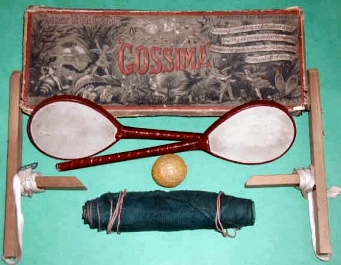|

HISTORY OF TABLE TENNIS
The origin of table tennis has never been exactly pinpointed,
even though it's a relatively young sport, younger than lawn tennis and not much
older than basketball.
The earliest known form of the sport, called indoor tennis, was
played in the early 1880s by British army officers in India and South Africa,
using lids from cigar boxes as paddles and rounded corks from wine bottles as
balls, with a row of books set up across the middle of a table to form the net.
Other versions developed in England during the 1890s, known
variously as "whiff whaff" and "gossima," and Parker Brothers began
manufacturing an indoor tennis kit that included a portable net that could be
set up on a table, a small ball covered with netting, and miniature paddles.
James Gibb, an Englishman who visited the United States in 1900,
brought some hollow celluloid balls home and began playing indoor tennis with
friends, using the new balls. Gibb apparently came up with the name "ping pong,"
representing the sounds of the ball hitting the paddle and then the table.
However, an English manufacturer of sporting goods, John Jacques,
registered "Ping Pong" as a trade name in 1901 and sold American rights to
Parker Brothers, who came out with a new kit under that name.
Another Englishman, E. C. Goode, in 1902 covered his wooden ping
pong paddle with pebbled rubber, which allowed him to put spin on the ball. A
Ping Pong Association was founded in England that year, but it lasted less than
three years, mainly because Parker Brothers' control of the name made equipment
rather expensive.
Nevertheless, the sport spread rather quietly in England and
Europe, primarily with equipment marketed by other manufacturers using the
generic name of table tennis. A new Table Tennis Association was established in
England in 1921. It was followed by the Fédération Internationale de Tennis de
Table (International Table Tennis Federation), founded at a 1926 meeting in
Berlin by England, Sweden, Hungary, India, Denmark, Germany, Czechoslovakia,
Austria, and Wales.
The first world championship tournament was held in London in
1927. From then until World War II, Hungary dominated the sport. The top players
of that early period were two Hungarians: Maria Mednyanszky, who won seven
women's championships, and Viktor Barna, a five-time men's champion.
Czechoslovakia and Romania also produced several champions.
The American Ping Pong Association was organized in 1930, but its
membership was limited because only Parker Brothers equipment could be used. Two
rival organizations, the U. S. Amateur Table Tennis Association and the National
Table Tennis Association, were founded in 1933. The three groups merged in 1935
into the U. S. Table Tennis Association, which was renamed U.S.A. Table Tennis
in 1994.
Central European dominance continued for a time after World War
II, but Asian players took over the sport beginning in 1953. One factor in the
sudden emergence of Asian stars was the introduction of the foam rubber paddle
by Japan's Horoi Satoh in1952. The new coating made the game faster and also
allowed players to put even more spin in the ball.
Asian players also developed the "penholder" grip, in which the
handle of the paddle is held between forefinger and thumb, which allows the
player to strike the ball with the same face of the paddle on any stroke. That
grip is now used by virtually all top international players.
Table tennis became an Olympic sport in 1988, with singles and
doubles competition for both men and women.
Source : Hickoksports.com |